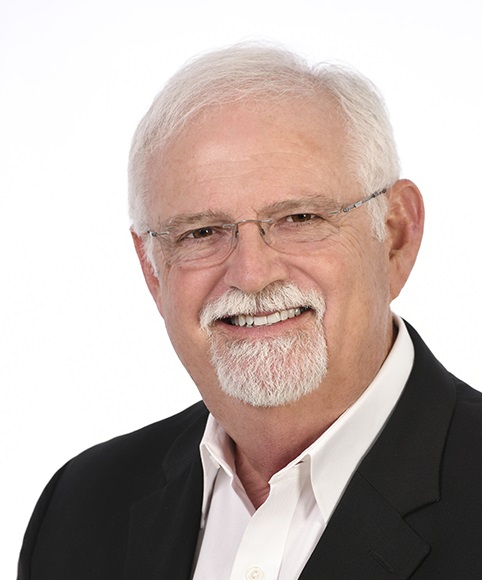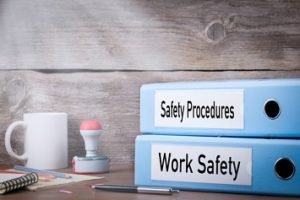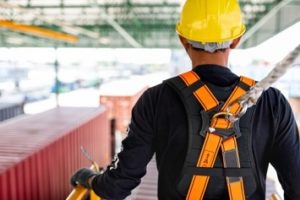In our most recent episode of EHS on Tap, we spoke with Terry L. Mathis, founder and CEO of ProAct Safety, about the challenges and opportunities that await safety professionals in the new decade. Terry will also be presenting the opening keynote address titled What’s Next for the Workplace Safety Professional: A 20/20 View on day one of the EHS Daily Advisor‘s upcoming Safety Summit taking place April 6th through 8th in Indianapolis, Indiana.
The podcast was originally published on March 5, 2020, and if you’d prefer, you can find the full audio here.
Justin Scace: Hello everyone and welcome to EHS on Tap. I’m your host, Justin Scace, Senior Editor of the EHS Daily Advisor and Safety Decisions Magazine. The EHS profession is constantly evolving and these ongoing shifts present both challenges and opportunities. We’ve all heard that hindsight is 20/20, but today we’re looking to provide our listeners with some foresight into what to expect on the safety front as we progress through the year 2020. With that goal in mind, we’re talking with a veteran safety professional who can guide us through a little bit of what the future may bring, from the need to develop new professional skills to the influence of technology on safety.
Joining us today on EHS on Tap is Terry L. Mathis, the founder and CEO of ProAct Safety, an international safety and performance excellence firm. Terry is known for his dynamic presentations and writing in the fields of leadership, operational performance, and behavioral and cultural safety, and he is the coauthor of Lean Behavior-Based Safety: BBS for Today’s Realities; Forecasting Tomorrow: The Future of Safety Excellence; Steps to Safety Culture Excellence; and Developing a Safety Culture: Successfully Involving the Entire Organization.
Terry will also be presenting the opening keynote address titled What’s Next for the Workplace Safety Professional: A 20/20 View on day one of the EHS Daily Advisor‘s upcoming Safety Summit taking place April 6th through 8th in Indianapolis, Indiana. So thanks very much, Terry, for sitting down to chat with us on EHS on Tap.
Terry Mathis: Good to be with you, Justin.
Justin Scace: Great. So tell us a little bit about your background. What made you pursue a career in safety and what are some of your favorite things about working in the field?
Terry Mathis: Well, my corporate career was at Coca-Cola, and I was assigned more and more safety related issues in that, in training and developing programs. And I just started falling for it. It was very challenging. It was very altruistic. It was relatively new at the time. I’m the same age as rocks and dirt. So I was around when OSHA first started and there were no colleges turning out people with safety degrees. So we had to look around Coca-Cola and say, “Who would make a good safety professional? And how do we develop them? Where do we send them? And what publications do we get them reading?” And it was just a challenging new thing to do. And as I got into it more and more, I really got fascinated not only with the challenge but with the altruism of it. I knew we were preventing injuries, I knew we were preventing fatalities even.
It’s a little bit frustrating, you did not know whose life you saved, but it was very altruistic to know that you were saving lives and saving misery for people. So as I got more and more into it, Coca-Cola gave me more and more advanced programs to develop and finally gave me the challenge of just saying, “We’re on a plateau. How do we get to the next step change?” And I was able to use their deep pockets and tremendous resources to go out and hire some of the brightest and the best in the world, and figure out exactly what that was all about. And in doing that, we discovered what’s become behavior-based safety today.
We also discovered that our culture wasn’t what it needed to be. And so we started working on shaping the culture into more of the kind of culture that was capable of safety excellence. Anyway, I just got pulled in deeper and deeper in the whirlpool that I’ve found myself in, in that. And then, when I did that last project, my boss put his arm around my shoulder and said, “Great job, Terry, next project.” And I said, “I kind of like this stuff.” And I left my career at Coca-Cola and started this company and that was 26 years ago last November.
Justin Scace: So your upcoming talk at Safety Summit is about what’s next for safety professionals in 2020, what are some of the biggest challenges and opportunities facing us in the coming year?
Terry Mathis: Well, I think safety professionals are going to find themselves tugged out of their traditional role into some other roles that some of them might not be terribly comfortable with. I think instead of just working on the workplace and trying to make a safe workplace and compliance, they’re going to find themselves necessary for them to work with people. And a lot of them have great technical skills and weaker people skills. And I think they’re going to have to shore those up, and really learn how to work with cultures and how to work with behaviors, how to work with individuals. And I think the focus of safety is going to turn a little bit away from the physical environment and more toward the people in that physical environment. But the physical environment thing will never go away because it’s just too important a part of safety. But that’s where the vast majority of our effort has gone over the last 50 years.
I know at Coca-Cola, we spent tens of millions of dollars making the workplace safer. And really the reason that I was given this project was because that money was no longer producing results. We’ve spent more money on the workplace and we didn’t get any better results out of it. So we started spending the money on people and that’s where we found our opportunity was for further advancement. And I think that’s going to be one of the challenges. And of course technology too, technology is just running away with us. I know we’re going to talk about that probably in more depth a little bit later, but it’s interesting. You pointed out that hindsight’s 20/20, the year’s 2020 also, so maybe our vision is going to clear up.
You know, any projections though are crystal balling the future and they’re never exact, because there are variables in there that we can’t predict, but the trends are pretty well aligned right now. I mean, I think we can more clearly see where safety is going for the next 10 years and we haven’t been able to for the past 50 years. So I think that’s encouraging. We’re not going to get ambushed nearly as much as we have.
Justin Scace: And now I’d like to talk a little bit about some specific aspects of safety we’re looking at for 2020. First up: compliance. Anything in particular that we should be expecting from a regulatory or enforcement angle?
Terry Mathis: Well, without getting into politics, it seems like every administration has either fanged or defanged OSHA. And I think depending on what happens in … I think this year we’re in the defang mode and I think there’s going to be a lot of license for people to do whatever they want to do out there in the workplace more than not. However, that said, I’ve seen some pretty strict regulatory enforcement going on under this particular administration, but I mean, if this administration goes on, it’s going to be predictable. If they get replaced, there’s going to be a big unknown out there in the future.
I don’t personally get terribly involved in compliance issues. I consider those fairly basic and there are a lot of experts in compliance out there in the world. I didn’t feel like they needed another one. So what I work on mainly it’s above compliance. I consider compliance the foundation of a safety program. And I’m trying to add on the 120th floor up on the skyscraper. So, I don’t keep up with exactly what’s going on, but if your organization doesn’t do that, you’re doing it at your peril, you better be legal. You better keep yourself out of that particular exposure.
Safety’s all about limiting exposure and managing risk and the risk of noncompliance is huge. So if you’re not addressing that, address that. Then once you get on top of that, that’s where my expertise can come into play.
Justin Scace: Now, as you’ve been talking about a little bit, the big conversation these days is about taking safety beyond just compliance. Safety professionals need to develop their soft skills and engage in things like effective safety leadership and promoting a healthy safety culture. What are some new developments on this front?

Terry Mathis: Well, it’s interesting your point of view here. If you want to know, if you really need to work beyond compliance, get a group of your employees together or several groups of your employees together and ask them this question, “Can you obey all the rules, follow all the procedures, wear all your prescribed PPE, and still get hurt?” I think you’re going to find universally they’re going to answer yes. So do you need to work beyond compliance? Obviously so. If you can be totally in compliance and your employees can still get injured, there’s something beyond that you ought to be working on. So yes, there are a lot of advancements in this, and I consider myself not the pioneer, but one of the pioneers in safety culture.
I wrote a book about it in 1996, which preceded all but one other book that was ever written about safety culture. It’s an ill-defined goal. A lot of companies want one, but they don’t know exactly what one is. And companies like DuPont have come along and said, “Well, it’s like Stephen Covey described, you ought to go from dependent to independent, to interdependent.” And a lot of people caught that vision and said, “Yeah, that’s where we need to go.” The problem is that, they didn’t give them the methodology to get from one to the other. And a lot of organizations don’t realize that if you don’t change your management style, if you have a command and control micromanagement style, your culture is not going to go from dependent to independent. You’re working against yourself to make that happen.
So I wrote an article about a year ago and I put a grid in there and I said, “If you want your culture to go from this to this, to this, here’s what your management style has to do. Here’s what your strategy has to do, here’s how your safety professionals have to evolve their roles to make that happen.” And it was just a grid of what you have to do to make that happen. And I think that’s what’s lacking in a lot of these efforts in safety, is the methodology. People know where they want to go, they have an idea of what they want to accomplish. They just don’t have a clear roadmap of how to get there.
And I think that’s one of the things that organizations are going to start developing. In fact a couple of roadmaps that they’re going to develop in 2020 that are going to clearly lead them to where they need to go in the future.
Justin Scace: So of course no discussion of the future would be complete without talking about technology. How is technology changing the safety landscape and what resources are out there to help professionals keep up with the pace of change?
Terry Mathis: Well, I think there need to be some more things out there to help us keep up with the pace of change, because the pace is outrunning all of us. There are so many fields that are advancing so quickly. And really the interesting thing to me is that the technology is not advancing as fast as the price of technology is coming down. And there are several things that I advised people to use 10 years ago that were outrageously expensive that today are so cheap you can’t avoid using them.
I’ve been asked for years, for instance, how you predict and how you rotate people working on the Gulf Coast in the summer heat? How often should you rotate them to make sure they stay hydrated and don’t get a sun stroke? The problem is this is different for every individual. And about 10 years ago they came out with a little gadget, you could stick something on someone’s chest, do three little things, almost like an EKG on their chest. It would talk to their smart phone and tell them when they needed to take a break.
Well, those things cost $1,400 10 years ago; they cost $70 today. So you can equip a whole crew of 300 people cheaper than you can pay for one sunstroke. It’s just that the technology is coming down. Dow Chemical, just to give you an example, Dow Chemical did over 3,000 confined space entries last year. 1,800 of them were robotic. Isn’t that amazing? So we’re saying, “How do we do confined space safely?” Well, stick a robot in there instead of a human being. And the robots are coming down in price so quickly, it’s amazing.
Falls from heights have always been a challenge and a lot of tall inspections of tall stacks and powers and things like that. They’re all being done with drones. And the drones have come down in price to where you can’t afford not to have a drone. I just had the roof replaced on my house and they flew a drone over it and the drone told the computer exactly how many squares of shingles it needed to roof my house. I mean, even down to low level things like this, it’s amazing.
But the other thing, the real amazing thing about this technology to me, I’m in several debate groups and think tanks and people are saying, “Well, don’t worry about this, Terry. We’re going to replace human beings in factories over the next few years anyway.” I don’t think it’s going to happen. First of all, the robotics for a fully robotic factory is still so expensive that you can operate a factory with human beings and they’re doing a lot of the work for the next 20 years before you get the ROI on that robotic factory. So money’s going to be the determination not just the technology. That technology is going to have to come down in price. But what’s interesting right now is that the main thrust of the technology is not designed to replace people. It’s designed to enhance them.
Exoskeletons and things like that. I mean, you can buy a basic exoskeleton cheaper than you can pay for a back injury, and that’s going to lead people to it. But the other thing that’s encouraging is that the vast majority of the technology that’s now become so cost effective is technology that will not replace human beings, but enhance them. But the other thing is I’ve been concerned for years being an old guy like I am, that this generation that’s coming up, that didn’t grow up on farms and ranches, didn’t take shop in high school, that sat on the couch doing things with their thumbs was not going to be a very good fit in industry. Guess what it takes to operate that robot that does the confined space? It takes somebody really good with their thumbs.
Guess what it takes to fly that drone up there and do visual and do high-level inspections? It takes somebody that’s good with their thumbs. These kids, as this technology comes into place. They’re going to be perfect for the 2020 workplace. It’s very encouraging to me, because I’ve been really concerned about that, that we’re going to bring these kids into something they can’t handle and get them injured. And I think we’re going to bring them into something they can handle better than the old folks can, as we start bringing this technology to bear.
Justin Scace: Do you think, if I could just ask a quick side question here, do you think that there is enough awareness among safety professionals that this technology even exists?
Terry Mathis: No, definitely not. I just came from ASSP’s, I’m sorry, I haven’t get used to that terminology. ASSP’s used to be called Seminarfest. It’s now called SafetyFOCUS I think. I didn’t hear very much about it there. I was at NSC’s big conference back in October. I didn’t hear enough about it there. I was at ASSP’s conference last June. I didn’t hear enough about it there. The only place that I’ve gotten a dose of it really is at National Safety Council’s Campbell Institute. That’s trying to be the leading edge and they’ve invited a lot of technology folks to come in and present there. But that’s the only place I’m finding it. And I mean if only a couple hundred of the leading high-level executives in the country are hearing this, we’re missing a lot of the audience out there.
I mentioned roadmaps. I think one of the things that safety professionals need to develop in 2020 is a technology roadmap. They need to go out there and research where their greatest risks are and what the new technologies are to help them address those and at least start making a tentative plan of when and over what period of time they can bring those to bear. I work with a lot of construction companies, especially pipeline construction companies. The number one cause of their most serious accidents is catching people behind pieces of equipment or between pieces of equipment. There are sensors out there right now that will tell the operator, that piece of equipment, if there’s a human being in their blind spot and it’s coming down in price.
And a lot of the companies have said, “Well, Terry, it’s going to take us a decade to get those in place out here, to be able to afford them and cost effect.” I said, “Come for your supply chain, let your supply chain, wherever you’re buying your equipment from, make that one of the requirements of the equipment and you’ll be able to finance it through your equipment acquisition.” I think those are the kinds of things that safety professionals are going to need to be addressing and thinking about this year and for the next decade.
Justin Scace: So you’re a veteran of over 1,600 safety performance improvement engagements and not just in the US, you’ve been to 39 countries to help organizations improve safety. From your wide perspective, how is safety poised to change worldwide versus nationally in 2020? How are the changes different? And how are they the same?
Terry Mathis: Well, it’s interesting, one of the things that I learned in my Coca-Cola career and have carried into ProAct Safety is the necessity of making processes that fit cultures, not making cultures that fit processes. And I think one of the things that’s being realized more and more. When I first went to France or when I was first looking at going to France, I met a lot of resistance over there. We adapted several processes that we did over there, especially behavior-based safety to the French cultures. We made it friendly, we made it fit the cultures we made it fit the language, the terminology and everything where it wasn’t misunderstood.
And I always remember one of the experts for one of the big consulting companies caught me one time in London and said, “Terry, you know you can’t do behavior-based safety in France.” And I said, “I really wish you had told me that before I had 10 successful implementations over there. If had known it wouldn’t be possible, I probably wouldn’t have tried it.” But the interesting thing is I think what we’re realizing is we don’t need … well, the culture conversation is going right, well, your culture formed over decades, over centuries. It’s going to take that long to change it again. We don’t want to change an entire culture.
And I think one of the things that is going to be realized and it’s starting to be realized in this next few years is that we only need to change a few aspects of a culture. And we certainly don’t need to change the personality aspects of the culture. Try changing a German into a Frenchman or a Frenchman into a German, I mean their personalities, their background, their ethnicity is just so different. But that’s not what you want to change. You don’t want to go in and change a person’s personality, because I’ve tried not to do that, what I’ve been able to do is I’ve been able to make safer Frenchmen and safer Germans.
They’re still Frenchmen and Germans, but they’re safer than they were before. And I didn’t try to change the basic things in their culture. I just changed a few key elements in their culture that would help them avoid accidental injuries. And I think that’s one of the things that’s going to happen in the world is that the consultants who would like to and the leaders even in organizations, who would like to have everybody be a cog in a wheel, are going to realize that not everybody’s a cog in a wheel and they’re going to have to treat them individually and even by cultures and by groups. And that’s radically different.
Someone said, “wow, you went from Korea to France. That must be a radical difference.” Well, let me tell you something. I’ve gone from Arkansas to California and seen that much difference. Every culture is unique and individual and if you don’t make the processes that you’re trying to implement fit those cultures, even if you make them work, they won’t last.
Justin Scace: That’s great. Now before we sign off, any other previews, advice, or stories you’d like to share with our audience regarding your opening keynote address at Safety Summit 2020?
Terry Mathis: Well, one of the things that I really appreciate and don’t appreciate about events like this is they always want my slides early. Some of my best ideas can come on the airplane on the way to the event. So what I try to do is turn in some generic slides that are mainly pictorial and not words and everything like that and then fill them in on the back end. If you have safety events, let them be current. We haven’t innovated a lot of things in safety over the last 50 years. We’ve done basically the same things and we’ve been trying to make those same things better rather than making new good things. In marketing, there was a book that came out a number of years ago called Blue Ocean Marketing.
And they basically said, “In marketing, we try to have the best thing on the island.” But what happens when you go out and find a new island? And we’ve done that. Steve Jobs said, “Nobody knew they wanted a smartphone until I made one.” He created a whole new market and look at the size of that market right now. So, now we’re back to island thinking, who can make the best smartphone? Who can give you the best service? You see the ads all over television. Nobody’s saying buy a new smartphone. They’re also saying, “Change from theirs to ours.” Like that. I think it’s time in safety that we do some Blue Ocean thinking. I think it’s time in safety that we say, “It’s not enough to have safety meetings and safety training and safety supervision and things like that. What else can we do?” And these new technologies are going to present a lot of opportunities for those kind of things, if we’re innovative.
I’ve already got companies that never could get their drivers to a safety meeting, because they had to be driving during the time the meeting was. They’re using podcasts and listening to them in their trucks on the way there. I’ve got cultures that people have never seen each other, but they’re developing a culture, because they’ve got a Facebook page and they’re all talking to each other on Facebook on their phones and they’re sharing ideas, sharing best practices. I think we need to shake up our old thinking in safety and get into 2020. It is a new decade. It’s a new century. And it’s time that we start thinking that way and start questioning all these old practices that we’ve had forever.
They’re not all bad and they don’t all need to be abandoned, but they do need to be questioned. And we need to say, are we doing safety the best way that we can possibly do it? Not just are we doing the basics the best we can … the same old things the best we can do those. It’s like Kaizen and Kaikaku. If you’ve been making a fountain pen better and better all the years, at some point you have to ask yourself, why are we making a fountain pen? Why aren’t we making a felt tip or a laser pen or whatever like that? I think the same thing’s happening in safety. It’s time to say what’s next? Where do we go from here?
Justin Scace: That’s great. Great. A lot of things to pay attention to in safety this year. We’re looking forward to hearing your keynote at Safety Summit 2020, Terry, and thank you once again for being with us today on EHS on Tap.
Terry Mathis: Thank you. Good to be with you.
Justin Scace: We now like to take a moment to invite our podcast audience to join us in person for Terry’s opening keynote at the EHS Daily Advisor‘s upcoming Safety Summit 2020 taking place April 6th through 8th in Indianapolis, Indiana. The conference will cover all aspects of safety management, and it promises to be an enlightening and engaging event. So visit live.blr.com today to register or click on the links and banners that appear on this podcast episode’s EHS Daily Advisor webpage. And as always, look out for new episodes of EHS on Tap and keep reading the EHS Daily Advisor to stay on top of your safety and environmental compliance obligations. Get the latest in best practices, and keep your finger on the pulse of all things related to the EHS industry. Until next time, this is Justin Scace for EHS on Tap.
 Terry L. Mathis is the founder and CEO of ProAct Safety, an international safety and performance excellence firm. He is known for his dynamic presentations and writing in the fields of behavioral and cultural safety, leadership, and operational performance, and is a regular speaker at ASSE, NSC, and numerous company and industry conferences. He is a veteran of over 1600 safety, culture and performance improvement engagements in 39 countries, and has personally assisted organizations such as Georgia-Pacific, Williams Gas Pipeline, US Pipeline, Herman Miller, AstraZeneca, Wrigley, ALCOA, Merck, Rockwell Automation, AMCOL International, Ingersoll-Rand, The United States Armed Forces and many others to achieve excellence. He has been a frequent contributor to industry magazines for more than 15 years and is the coauthor of Lean Behavior-Based Safety: BBS for Today’s Realities (SCE Press 2017), Inside Strategy: Value Creating from within Your Organization (SCE Press, 2016), Forecasting Tomorrow: The Future of Safety Excellence (SCE Press, 2015), STEPS to Safety Culture Excellence (WILEY, 2013) and Developing a Safety Culture: Successfully Involving the Entire Organization (J.J. Keller & Associates, Inc., 1996). In addition to the books, Mathis has authored more than 100 articles and spoken at hundreds of private and public events. EHS Today has listed him four consecutive times as one of ‘The 50 People Who Most Influenced EHS’. Terry L. Mathis is the founder and CEO of ProAct Safety, an international safety and performance excellence firm. He is known for his dynamic presentations and writing in the fields of behavioral and cultural safety, leadership, and operational performance, and is a regular speaker at ASSE, NSC, and numerous company and industry conferences. He is a veteran of over 1600 safety, culture and performance improvement engagements in 39 countries, and has personally assisted organizations such as Georgia-Pacific, Williams Gas Pipeline, US Pipeline, Herman Miller, AstraZeneca, Wrigley, ALCOA, Merck, Rockwell Automation, AMCOL International, Ingersoll-Rand, The United States Armed Forces and many others to achieve excellence. He has been a frequent contributor to industry magazines for more than 15 years and is the coauthor of Lean Behavior-Based Safety: BBS for Today’s Realities (SCE Press 2017), Inside Strategy: Value Creating from within Your Organization (SCE Press, 2016), Forecasting Tomorrow: The Future of Safety Excellence (SCE Press, 2015), STEPS to Safety Culture Excellence (WILEY, 2013) and Developing a Safety Culture: Successfully Involving the Entire Organization (J.J. Keller & Associates, Inc., 1996). In addition to the books, Mathis has authored more than 100 articles and spoken at hundreds of private and public events. EHS Today has listed him four consecutive times as one of ‘The 50 People Who Most Influenced EHS’. |





